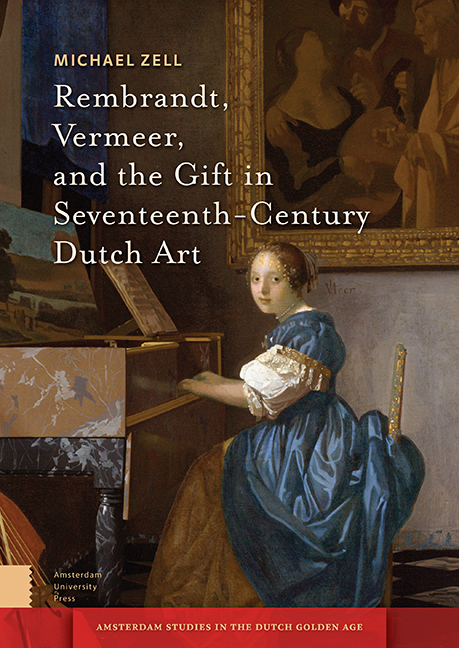Book contents
- Frontmatter
- Dedication
- Contents
- Illustrations
- Acknowledgments
- Introduction
- 1 The Gift and Art in Early Modernity
- 2 Art as Gift in the Dutch Republic
- 3 Rembrandt’s Art as Gift
- 4 Art and Leisure: Amateur Artists, Rembrandt, and Landscape Representation
- 5 For the Love of Art: Vermeer and the Poetics of the Gift
- Conclusion
- Bibliography
- Index
2 - Art as Gift in the Dutch Republic
Published online by Cambridge University Press: 21 October 2021
- Frontmatter
- Dedication
- Contents
- Illustrations
- Acknowledgments
- Introduction
- 1 The Gift and Art in Early Modernity
- 2 Art as Gift in the Dutch Republic
- 3 Rembrandt’s Art as Gift
- 4 Art and Leisure: Amateur Artists, Rembrandt, and Landscape Representation
- 5 For the Love of Art: Vermeer and the Poetics of the Gift
- Conclusion
- Bibliography
- Index
Summary
Abstract
This chapter explores the distinctive gift culture and the gifting of art in seventeenth-century Holland. Although gift giving has been marginalized in studies of seventeenth-century Dutch art, gift exchanges of various kinds, including art, were widespread in Dutch mercantile culture. Giving gifts was considered obligatory for nurturing burgher professional and personal relationships, and gifts of art played a key role in the Republic's diplomatic engagements. Like their colleagues elsewhere, Dutch artists mixed gifts with sales transactions by offering their works as gifts to potential and established patrons, contacts, and familiars. Discussion of the special cases of Rembrandt and Vermeer is reserved for later chapters, but here examples of gifts by Hendrick Goltzius, Jan Lievens, Govert Flinck, and others are addressed.
Keywords: Gifts; Gift Giving; Diplomatic Gifts; Dutch art; Economics of Art; the Dutch Republic and Early Capitalism
Gift giving was deeply embedded in the mercantile culture of the Dutch Republic. Gifts of art were also common, circulating along a spectrum of social registers to give expression to and materialize webs of public affiliation and personal affinity. Dutch political and institutional authorities presented gifts of paintings and other art objects to facilitate political alliances and forge trade agreements, while private citizens offered gifts of art to nurture professional and personal bonds and enact cultural distinction. Rembrandt famously gifted his art, as we shall see in the next chapter, but other Dutch artists also gave their works to patrons and intimates, mobilizing the gift economy to cultivate business and social relationships defined by honor, virtue, mutual regard, and mutual interest. Yet the Republic's identity as a burgher society has deflected attention away from its gift culture and gift giving's role in its thriving art market. This chapter clarifies the importance of the symbolic economy of the gift in Dutch social, political, and commercial life, and tracks gifts of art as a form of cultural currency among burgher elites, cultural figures, citizens, and artists. In this merchant polity's unique political, social, and economic circumstances, gift giving functioned not apart from but within a vibrant, market-oriented artistic culture.
The Problem of the Gift in Studies of Golden Age Art
Although some of the most famous episodes in the gifting of art were initiated by the Dutch Republic and documents record that Dutch artists presented their works as gifts, such transactions are seldom emphasized in the literature on Dutch artistic culture.
- Type
- Chapter
- Information
- Publisher: Amsterdam University PressPrint publication year: 2021



